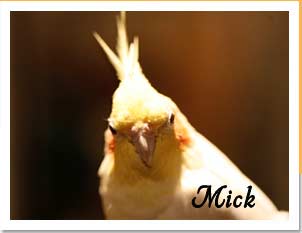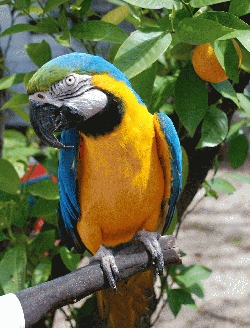Considering a “Starter Bird”?
By Jonathan Harris
|
You see the phrase everywhere—pet magazines, big box pet stores, on-line ads: “great starter bird.” Budgies and cockatiels especially are described as good starter birds or starter parrots. In fact, smaller birds often are marketed as starter PETS—fairly inexpensive, easily cared for in a small space, relatively undemanding in terms of interaction—a way for children to learn responsibility and respect for life before getting a cat or dog. |
Tammy Azzaro had another term for these species—the throw-away birds.
Whenever I encounter the phrase “starter bird” or “starter pet” I feel a chill. “Starter” to me suggests “practice,” something not quite real, permanent or important, a rough draft, a laboratory for trial and error, disposable, replaceable.... Do we talk about a “starter marriage” or “starter children”? The whole concept falls somewhere between troubling and obscene.
True, there are species whose size and temperament make them problematic choices for people with limited space or bird experience. But ALL birds have qualities that make them more difficult to care for adequately and integrate comfortably into human households than, say, dogs and cats, who have adapted to domestic cohabitation over thousands of generations. With the possible, partial exception of some domestic pigeons and poultry species, caged birds (especially parrots!) still remain essentially wild animals. The conditions in which we keep them are foreign to their nature and needs to the point where they grade into cruelty. Birds require exercise; they are designed to fly and have a profound desire to do so; yet they are often confined to small cages. Parrots and most bird species are flock animals and crave the constant company of others; yet they often are kept as single animals, isolated, and deprived of attention most of the time.
People often have the misconception that birds are relatively simple creatures, simple-minded, content to stay in a small cage with a mirror and bell, living a circumscribed life as remote and easy to care for as in an aquarium. In fact, as we know, they are deeply emotional and highly intelligent animals with cognitive abilities equal to those of Primates and Cetaceans and young human children. They need activity, mental stimulation, emotional attention and social interaction. When those needs are not met, when they are deprived or neglected, they suffer in ways only intelligent creatures do and can quickly become hard for their human companions to manage or sometimes even tolerate.
Smaller does not mean simpler, dumber, or cheaper. The bird with the largest recorded vocabulary was a 4-year-old budgie! (By the time of his death, little Puck had amassed a documented vocabulary of almost 1,800 words, which he used with surprising creativity). It is noteworthy that budgies also self-mutilate, like bigger parrots. A sick or injured bird is no less expensive to treat than a larger animal, and avian veterinary care can be much harder to find.
Looking at my relations with birds over the past decade, an observer might say that Patricia and I followed the “starter bird” model almost to the letter. We began with canaries, followed by a cockatiel some years later, a conure six months after that, and then adding a companion of the same species for the parrots over the next few years. For the first three birds at least, each new addition was larger and demanded more attention, but also supposedly offered the possibility of deeper interaction.
But that would be such a poor account of what really happened, which was not a process of gradually building understanding (which admittedly we did) so much as a fundamental change of perspective—more akin to a religious conversion experience, in which one enters a circle of understanding from inside which it feels incomprehensible to not have seen before what now seems so clear.
Our first canaries were practically an impulse buy from a pet store. We had a decent guidebook and tried to make them happy, giving them vegetables and treats and out-of-cage time to fly and forage. But both had health problems and we really did not understand how to care for them, so they died, nameless, after just a few years. During their brief lives, the strongest feeling I recall towards them was pathos—sorrow and pity for their cloistered lives, but something I felt from outside their cage, looking in, alienated and powerless.
Canaries and cockatiels meet for friendly foraging and to commiserate over being labeled "starter birds." |
The next canaries were healthier, and I felt a bit closer to them, maybe because we bought them as solace for our widowed birds, as we lost the original female and then the male. It was only really with Chulo the cockatiel, though, that I started to experience anything like a personal connection. Even though he could be stand-offish and wouldn’t accept preening, Chulo was a charmer. |
He could be chatty in an interactive way, playful, and physically affectionate. He even regurgitated seeds on me once—such an honor! Still, I was on the edge of the circle looking in. I had begun to see that the consciousness in this small creature was far more human-like than I had imagined, but I did not know yet what to do with that knowledge or those feelings.
Paco the blue-crowned conure is the one who suddenly pulled me in, when, barely a week after we got him, the 7-month-old bird looked at me as I walked into the living room and said “Hello!” From that point, I could never think of him except in partially human terms.
|
As Paco’s vocabulary grew and our relationship deepened, something else astonishing happened. I became aware of all the other birds’ behavior in ways I never had been before. I noticed that when Paco said “Patricia will be back!” for instance, the cockatiels would start urgently chirping their contact calls. Sometimes I would hear the male canary imitating Paco’s words or the cockatiels’ wolf whistles. And sometimes I’d hear him warn the flock of hawks with a cry they all recognized. I realized all the birds were constantly communicating with one another as well as with us, and that in each case those communications expressed the intelligence and feeling of a unique spirit. |
In the 4–5 years since then, everything has changed. We named our canaries. We became involved with Mickaboo and adopted two more birds. I want to understand this flock and make them as happy as possible. I will never think of birds the same way again. And all this because Paco in effect was there to translate for the others. Paco was really the starter bird.
They can make wonderful companions. They can change your life, make you a better person, possibly even save your soul. But they don’t come cheap. They are demanding and need a great deal of attention and care—certainly no less than a dog or cat, in reality probably a lot more. No one should get any bird casually or on impulse. If you’re seriously interested in what you can experience with an avian companion, educate yourself on their needs and personalities. One of the best ways is to avail yourself of the classes and resource guides offered by rescue groups such as Mickaboo.




 Friends Paco and Chulo taught us that
Friends Paco and Chulo taught us that